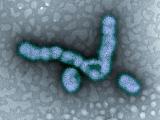Apr 23, 2009 (CIDRAP News) – Five more cases of an unusual swine influenza virus infection have surfaced, officials from the US Centers for Disease Control and Prevention (CDC) announced today, bringing the total to seven and raising more concerns about human-to-human transmission.
The new cases include two clusters, two 16-year-old boys in San Antonio, Tex., who attended the same school and a father and daughter from San Diego County. Anne Schuchat, MD, interim deputy director for the CDC's science and public health program, told reporters today at a teleconference that the clusters are consistent with human-to-human spread.
She also said that the World Health Organization has not raised its six-phase pandemic alert level above phase 3 (no or very limited human-to-human transmission).
The fifth new case occurred in a patient from Imperial County, which borders San Diego County. Both counties are home to the first two swine flu patients that the CDC announced on Apr 21.
News of the five new swine flu cases came on the same day Canadian officials warned its public health, medical, and quarantine workers to look for illnesses among Canadians returning from Mexico. Mexico has reported several cases of severe respiratory illness and has asked Canada to assist in finding the source of the illnesses, some of which have been fatal, according to a report today from the Canadian Press (CP).
Schuchat said no swine flu cases have been confirmed in Mexico or Canada, but that CDC officials are discussing the situation with Mexican health officials and representatives from the Pan American Health Organization (PAHO).
Novel strain, relatively mild symptoms
Concerning the seven American cases, Schuchat said, "The good news is that all of the patients have recovered, and one was hospitalized. This is not looking like a very severe influenza."
Patients experience fever, cough, and sore throat symptoms similar to typical influenza, but some of the patients who had swine influenza also experienced more diarrhea and vomiting than is typical of seasonal flu.
The CDC said genetic sequencing of samples from the first two patients, California children who lived in adjacent counties, show that the swine flu virus contains segments from four different viruses: some North American swine, some North American avian, one human influenza, and two Eurasian swine.
"This virus hasn't been recognized in the USA or elsewhere," Schuchat said.
CDC scientists have determined that the novel swine flu virus is resistant to the older antivirals rimantadine and amantadine but is susceptible to oseltamivir and zanamivir.
Schuchat said the CDC expects to see more swine flu cases and that it would provide regular updates on its Web site.
"This is not time for major concern around the country, but we want you to know what's going on," she said. Most of the public health response will focus on the California and Texas areas where cases have been identified, but the CDC is urging health departments in other states to heighten their awareness of respiratory illnesses, particularly in those who have had contact with pigs or traveled to the San Diego or San Antonio areas.
Schuchat said the CDC doesn't know yet if the H1N1 component of this season's influenza vaccine provides any protection against the swine flu virus, but she said studies are under way to determine if there is any cross-protection.
Expert reaction
Michael T. Osterholm, PhD, MPH, director of the University of Minnesota Center for Infectious Disease Research and Policy, publisher of CIDRAP News, said the findings, though concerning, don't mean that a pandemic is imminent.
However, he said health officials shouldn't take comfort in the fact that the illnesses so far have been mild. "The first wave of the 1918 pandemic was mild, too," Osterholm pointed out.
Walter Dowdle, PhD, who worked in the CDC's virology unit during the 1976 swine flu outbreak, told CIDRAP News that it's interesting but not greatly alarming that the 2009 swine flu strain contains such an unusual mix of gene segments.
"It's a real mutt," said Dowdle, who now works with the Task Force for Child Survival and Development, based in Atlanta. "When you have an evolving RNA mechanism, it's hard to be surprised by anything."
The H1N1 component of the seasonal flu vaccine might provide some degree of protection, he said. And if the swine flu virus persists, federal officials could consider adding an additional H1N1 strain to next year's vaccine.
Marie Gramer, DVM, PhD, a University of Minnesota veterinarian who has studied swine flu, said her preliminary examination shows that the outbreak strain doesn't appear to closely match anything currently circulating in pigs. However, Gramer added that she has only looked at a small number of viruses and only at the hemagglutinin gene.
Risk message implications
Peter Sandman, PhD, a risk communication consultant based in Princeton, N.J., also listened in on today's CDC teleconference. While he credited the CDC with getting a clear, calm, and concise scientific message out about the swine flu cases, he said they missed a teachable moment to promote pandemic preparedness.
"Everyone needs to learn how to say 'This could be bad, and it's a good reason to take precautions and prepare' and 'This could fizzle out,'" Sandman said. "They need to simultaneously say both statements."
He added that "good risk communicators need to know how to be both scary and tentative."
Federal health officials are probably treading cautiously around the word "pandemic," because some accused them of fearmongering when they raised concerns about the H5N1 virus 2 years ago and also because of overreaction during the 1976 swine flu epidemic that led to vaccination missteps.
When talking to the public about pandemic risks, federal officials could take some cues from hurricane forecasters, Sandman said, "and speculate responsibly."
Canadian officials probe Mexico illnesses
Canada's Public Health Authority (PHAC) said today in a situation update that Mexican authorities have asked its assistance in determining the cause of two clusters of severe respiratory illnesses that have occurred this month.
A cluster in Mexico City involved 120 cases and 13 deaths; the other occurred in San Luis Potosi, where 14 cases and 4 deaths were reported. Three deaths were reported from other locations: One from Oaxaca in southern Mexico and two from Baja California Norte, near the US border.
The PHAC report said the disease outbreak struck some healthcare workers and that most patients were previously healthy young adults between the ages of 25 and 44. Symptoms included fever, headache, ocular pain, shortness of breath, and fatigue that rapidly progressed to severe respiratory distress in about 5 days.
Mexican officials detected some influenza A/H1N1 and influenza B viruses, but have apparently ruled out H5N1 virus involvement. The PHAC said it received 51 clinical samples from Mexico for testing at its National Microbiology Lab.
Mexico told the PHAC that it had a late influenza season with an increasing number of influenza-like illnesses since the middle of March. The country also had a higher proportion of influenza B viruses than previous seasons.
See also:
Apr 21 CIDRAP News story "Human swine flu cases with unique train raise concern"
Apr 22 CIDRAP News story "Swine flu cases recall 1976 episode"
















